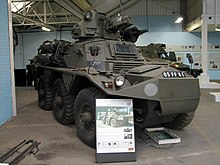FV603 Saracen
| FV603 Saracen | |
|---|---|

FV603 Saracen in the Yad-la-Shiryon Museum in Israel (2005) |
|
| General properties | |
| crew | 2 (driver, commander) + 9 infantrymen |
| length | 5.23 m |
| width | 2.54 m |
| height | 2.46 m |
| Dimensions | 11.0 t |
| Armor and armament | |
| Armor | 8 mm to 30 mm |
| Main armament | two machine guns |
| Secondary armament | no |
| agility | |
| drive | 8-cylinder gasoline engine Rolls-Royce B80 Mk6A 119 kW (160 PS) |
| suspension | 6 × 6 wheel suspension |
| Top speed | 72 km / h (off-road 32 km / h) |
| Power / weight | 10.5 kW / t |
| Range | 400 km |
The Alvis Saracen FV 603 is an armored personnel carrier vehicle (Engl. Armored Personnel Carrier ) of the British Army and police . Developed in the mid-1950s and built into the 1970s, it was mainly used in Northern Ireland , Africa and the Middle East.
History and technology
The Saracen is a six-wheeled armored personnel carrier in the weight class up to 14 tons, which was partly equipped with the small machine gun turret of the Daimler Ferret . On the roof of the rear combat area, which could be opened through a sliding hatch, a machine gun for air defense could also be mounted on a rotating ring. The idea of designing a wheeled vehicle with the same off-road capabilities as a tracked vehicle was as old as the idea of building a tank. It was successfully implemented with the FV600 series from Alvis Saracen, Alvis Saladin , Alvis Stalwart and Alvis Salamander . The armor was upgraded in several steps during active service from an initial 8–15 mm to up to 30 mm. The vehicle was designed to protect an eleven-man crew from armor-piercing infantry ammunition, mine explosions or the fragmentation effect of close-range hits by artillery . The Saracen was intended as an infantry support vehicle for heavy battle tanks .
The permanently driven 6 × 6 chassis was identical to that of the Alvis Saladin FV601.
Like all vehicles in these armored vehicles, the Saracen was also set up as a medical vehicle, command post, weapon carrier, mortar or fire control vehicle. In the 1970s, like many other British-made combat vehicles, it was used as an anti-tank launch vehicle for first-generation guided missiles with a ballistic trajectory.
The small combat tower, which was placed in the front third of the superstructure, was mostly equipped with a Browning M1919 machine gun in caliber 7.62 mm (NATO) which could be operated from the inside under light armor protection.
The Saracen was mainly used in Northern Ireland in the 1970s, where it was also used by the Royal Ulster Constabulary . However, it turned out that it was too immobile for use in the cities and could be completely immobilized with relatively little effort. Therefore, the Humber Pig , which was in principle still older, was used as a support vehicle.
From mid-1970, the single-layer armor, which was between 8 mm and 30 mm, and the engine power were no longer in keeping with the western military standard. Until it was decommissioned in the early 1980s, the Saracen was doing its job well. He can no longer be found in the arsenal of the British armed forces. The FV 432 became its successor. Today, the Saracen is still used by Indonesia and some Commonwealth countries such as India and will likely be in use in these countries until the 2020s.
Further technical data
- Ford depth: 1.07 m
- Trench crossing ability: 1.52 m
literature
- Philip Trewhitt: tanks. Neuer Kaiserverlag, Klagenfurt 2005, ISBN 3-7043-3197-X .
